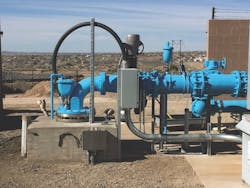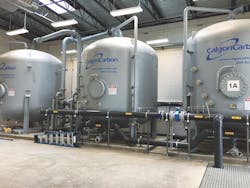About the author: Stephanie DuBois is project manager – capital improvements section for Rio Rancho. DuBois can be reached at [email protected].
The U.S. Southwest has been suffering from a severe drought the past seven years, according to National Oceanic and Atmospheric Assn. 2017 climate data. The city of Rio Rancho, N.M., is located in the heart of the Southwest region and has been placing heavy demand on existing deep groundwater wells to keep up with residents’ needs. In addition to heavily taxing groundwater resources, many wells contain arsenic, forcing the city to blend or treat each well—a costly and time-intensive activity. Rio Rancho is the third largest city in New Mexico with approximately 94,000 residents. The ongoing drought conditions and lack of reliable groundwater resources led the city to seek alternatives to supplement existing sources.
Trailblazing Aquifer Injection Projects
In 2001, Rio Rancho began a water conservation and management program, including plans for an aquifer injection project to ensure a safe and sustainable water supply.
To implement the aquifer injection project, a pilot study was conducted in 2011 to demonstrate that a high-quality reclaimed water source meeting EPA drinking water standards and New Mexico Water Quality Control Commission groundwater standards could be consistently produced for aquifer recharge. The pilot comprised 1 million gal of potable water injected daily into an aquifer for a period of 30 days. The water was pushed through an injection well to study the direction and rate of the water flow, as well as its impact on the water levels in the aquifer near the well.
Following the success of the study, the New Mexico Environment Department (NMED) approved Rio Rancho’s aquifer injection project, which became the first permitted aquifer injection facility of its kind in New Mexico. The facility will inject up to 1 million gal per day of treated water back into the aquifer, and the project has become a case study for many other communities across the state.
The direct injection well is 1,730 ft deep. When the water level reaches a certain height, the motorized butterfly valve on the inlet will close to close off the well.
Granular activated carbon tanks followed the advanced oxidation process to remove dissolved organic contaminants that can impact taste, odor and coloration of the water.
Groundwater Resource Support
In September 2015, Rio Rancho created an advanced water treatment facility to treat effluent from the Cabezon Water Reclamation Facility membrane bioreactor (MBR) process. The treated effluent is pumped approximately 2 miles through reuse lines to a 2-million-gal concrete storage tank that feeds the treatment facility through an electronically controlled flow control valve.
The facility also was equipped with an advanced oxidation process (AOP) followed by granular activated carbon (GAC) in May 2017. Rio Rancho was required to demonstrate that the AOP process was able to meet the proper performance criteria and objectives to ensure the protection of human health. To do this, Rio Rancho conducted another pilot test with a Xylem Mipro container.
System criteria included a 5-log virus disinfection barrier, less than 2.2 most probable number of total coliform, an ozone mass transfer efficiency greater than 89% and less than 10 micrograms/L of bromate control. The AOP process also uses a Xylem Wedeco Pro3mix ozone system, a plug flow reactor that removes endocrine disruptor compounds (EDCs), virus disinfection and bromate control ozone when combined with hydrogen peroxide.
Water is routed from the AOP through two treatment trains (347 gal per minute) via process pumps to the GAC tanks for removal of dissolved organic contaminants. These contaminants include taste and odor compounds, as well as organic color. Water from the GAC is then routed to a 1-µ canister filter system, and then to a degasser before it is injected with sodium hypochlorite solution for disinfection from the onsite generator.
The finished water is stored in a nearby steel tank prior to injection into the 1,730-ft injection well. A pressure transducer in the injection well reads the water level. When the water level in the well rises to a certain point, the motorized butterfly valve on the inlet header piping to the well will close. The flow rate into the injection well is controlled by the downhole Baski valve installed during the well construction during a previous phase.
The AOP treatment facility has been online for approximately six months since construction was completed. Only one train of the AOP system runs at a time, and two of the GAC holding tanks have not been filled with media due to the lack of available treated effluent from the Cabezon facility due to meeting other irrigation demands.
The AOP treatment system has been functioning well, but with the challenge of the degasser filter cartridges clogging faster than anticipated. This skid filter system is separate from the AOP system, causing the city to stop the injection process until the filters are replaced. Rio Rancho professionals are working with the manufacturer of the filter cartridges to determine a solution to the cartridge issue.
As of December 2017, the city had injected a maximum of 484,956 gal into the aquifer with a total organic compound of 0.91 mg/L and 6.30 mg/L of nitrogen. The city is currently waiting on sampling results for EDCs.
Based on the success of this project, Rio Rancho intends to pursue other direct injection locations to further implement water conservation and management measures. When municipalities combine innovation with reliable system solutions, challenging resource management—such as the water quality and scarcity situation in Rio Rancho—can be mitigated.


